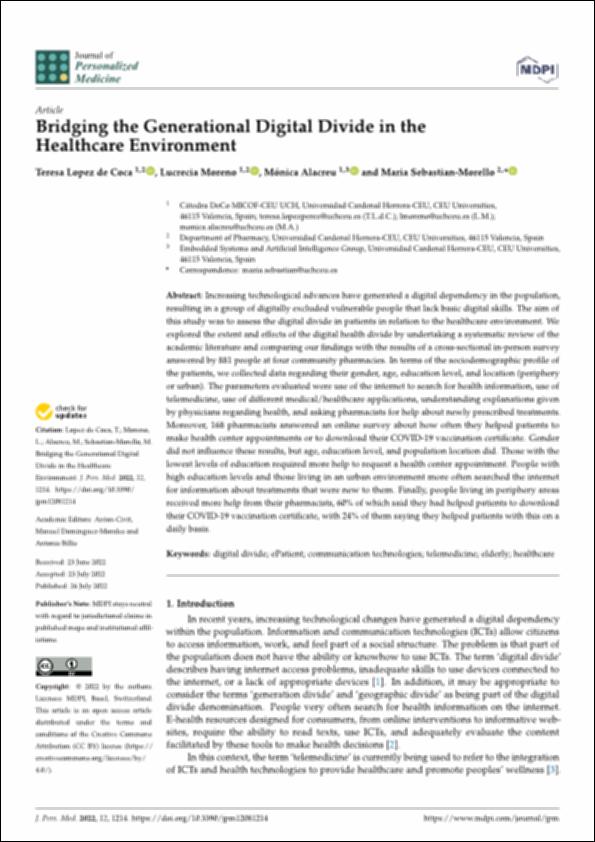Por favor, use este identificador para citar o enlazar este ítem:
http://hdl.handle.net/10637/14181Bridging the generational digital divide in the healthcare environment
| Título : | Bridging the generational digital divide in the healthcare environment |
| Autor : | López de Coca Pérez, Teresa Moreno Royo, Lucrecia Alacreu García, Mónica Sebastián Morelló, María |
| Materias: | Medicina - Innovaciones tecnológicas.; Telemedicina.; Brecha digital.; Medicaltechnology.; Medicine - Technological Innovations.; Telecommunication in medicine.; Tecnología médica.; Digital divide. |
| Editorial : | MDPI |
| Citación : | Lopez de Coca, T., Moreno, L., Alacreu, M. & Sebastian-Morello, M. (2022). Bridging the generational digital divide in the healthcare environment. Journal of Personalized Medicine, vol. 12, i. 8 (26 jul.), art. 1214. DOI: https://doi.org/10.3390/jpm12081214 |
| Resumen : | Increasing technological advances have generated a digital dependency in the population, resulting in a group of digitally excluded vulnerable people that lack basic digital skills. The aim of this study was to assess the digital divide in patients in relation to the healthcare environment. We explored the extent and effects of the digital health divide by undertaking a systematic review of the academic literature and comparing our findings with the results of a cross-sectional in-person survey answered by 881 people at four community pharmacies. In terms of the sociodemographic profile of the patients, we collected data regarding their gender, age, education level, and location (periphery or urban). The parameters evaluated were use of the internet to search for health information, use of telemedicine, use of different medical/healthcare applications, understanding explanations given by physicians regarding health, and asking pharmacists for help about newly prescribed treatments. Moreover, 168 pharmacists answered an online survey about how often they helped patients to make health center appointments or to download their COVID-19 vaccination certificate. Gender did not influence these results, but age, education level, and population location did. Those with the lowest levels of education required more help to request a health center appointment. People with high education levels and those living in an urban environment more often searched the internet for information about treatments that were new to them. Finally, people living in periphery areas received more help from their pharmacists, 60% of which said they had helped patients to download their COVID-19 vaccination certificate, with 24% of them saying they helped patients with this on a daily basis. |
| Descripción : | Este artículo se encuentra disponible en la siguiente URL: https://www.mdpi.com/2075-4426/12/8/1214 Este artículo pertenece a la materia "eHealth and mHealth: Challenges and Prospects". |
| URI : | http://hdl.handle.net/10637/14181 |
| Derechos: | http://creativecommons.org/licenses/by/4.0/deed.es |
| ISSN : | 2075-4426 (Electrónico) |
| Idioma: | es |
| Fecha de publicación : | 26-jul-2022 |
| Centro : | Universidad Cardenal Herrera-CEU |
| Aparece en las colecciones: | Dpto. Farmacia |
Los ítems de DSpace están protegidos por copyright, con todos los derechos reservados, a menos que se indique lo contrario.


